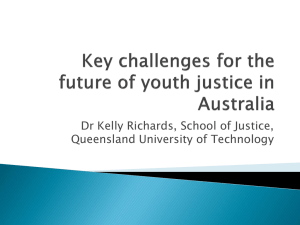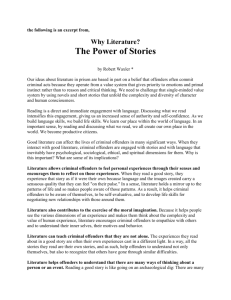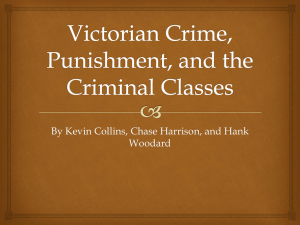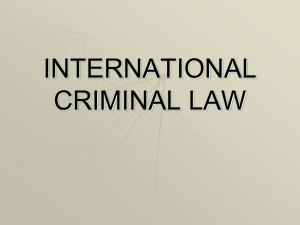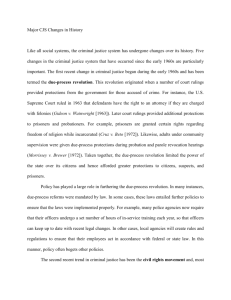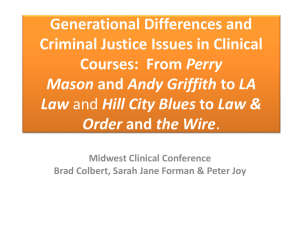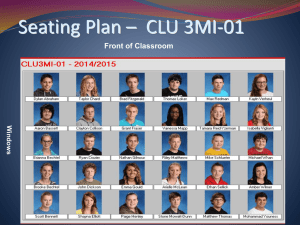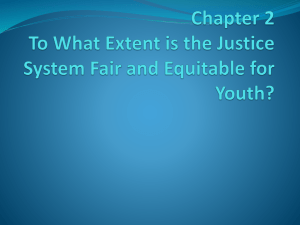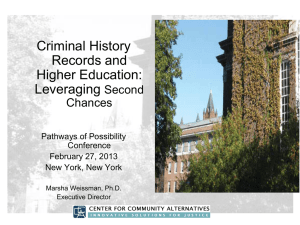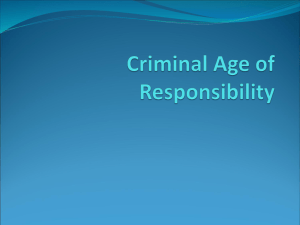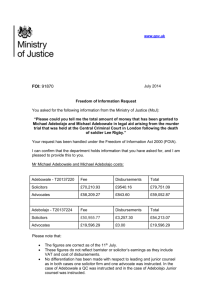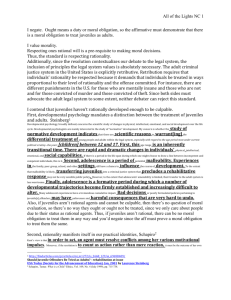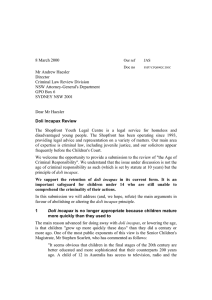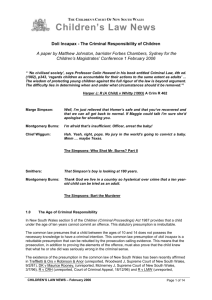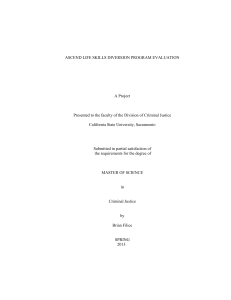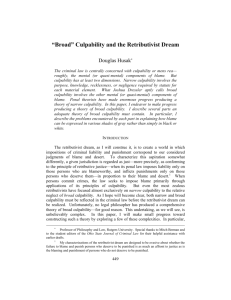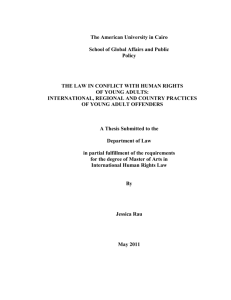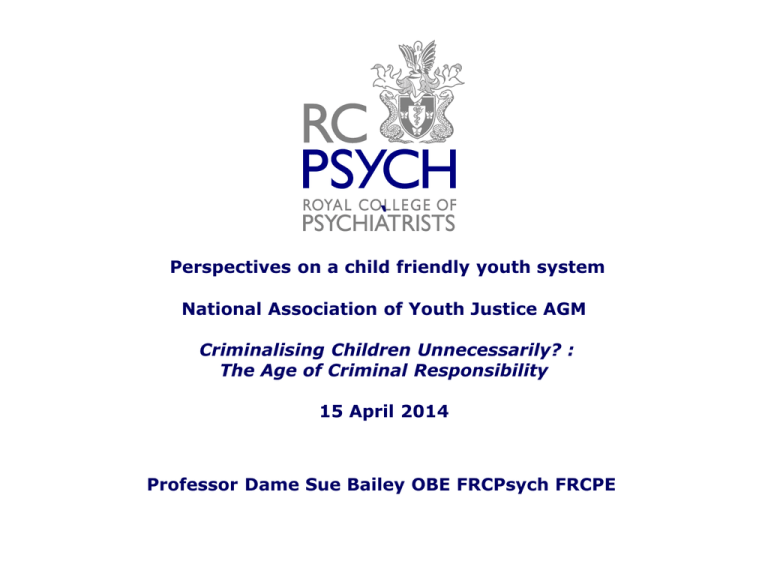
‘
Perspectives on a child friendly youth system
National Association of Youth Justice AGM
Criminalising Children Unnecessarily? :
The Age of Criminal Responsibility
15 April 2014
Professor Dame Sue Bailey OBE FRCPsych FRCPE
Recent History
Late 19 century
Queen Victoria modelled family life
Decrease demand for child labour
Increased emphasis on education
1895
Gladstone committee
Separation of young people in prison from adults
Recent History
1902
First YP prison in the village of Borstal
1908
Prevention of Crime Act
Education before punishment for 16 to 21 year olds
1913
Needs of young offenders recognised as heterogeneous
Mental Deficiency Act allowed DIVERSION of young offenders
with learning disability to appropriate institutions.
Real Recent History
1996
Audit Commission "Misspent Youth "
Adolescents committed a disproportionately high number of
crimes against the person
But also highlighted paucity of mental health, social care, and
educational involvement with young offenders and mandates a
multi agency approach
1998
Crime and Disorder Act
Introduced to reduce offending
YJB has been effective. Is the role now diminished?
Real Recent History
2006
Commissioning health care transferred from prison to Primary
Care Trusts
Now we have Clinical Commissioning Groups
So history has gone from Gladstone to CCGs and
Coalition
‘Keeping children and young people in the youth court and out of the
Crown Court - a discussion paper and proposal’
John Bache
Deputy Chairman, Magistrates’ Association
Professor Sue Bailey
President, Royal College of Psychiatrists
Lord Carlile of Berriew CBE QC
April 2013
Available via the NAYJ website
www.thenayj.org.uk
Recent legal and political history
The fall of a Doctrine
DOLI INCAPAX - a doctrine of over 700 years standing
Required
"The prosecution to adduce the evidence not only that the child
had committed the act alleged , but also that he or she knew that
behaviour in question was seriously wrong ,rather than just
naughty or mischievous"
It thus constituted a filter ensuring consideration of issues of
Maturity Capacity and Culpability at the point of charge and trial
Applicable up to 14years
DOLI INCAPAX
Labour government simply declared the doctrine to be :
"contrary to common sense"
The abolition of doli incapax was de facto an act of lowering the
age of criminal responsibility.
Rehabilitation of
Offenders Act - 1974
"If a 10 year old commits an offence considered to be a ‘grave
crime’ he or she will be tried in the Crown Court and may be
given a custodial sentence equivalent to that available in the case
of an adult“
Similarly a child of that age co-accused with an adult will be
subject to trial in an adult venue.
(Hansard, House of Commons,
column 171 WH – Crispin Blunt, 8
March 2011)
"Children aged 10 are able to distinguish between
bad behaviour and serious wrong doing. It is
entirely appropriate to hold them to account for
their actions if they commit an offence, and it is
important to ensure that communities know that
a young person who offends will be dealt with
appropriately. We have no plans to change the
age of criminal responsibility“
(Hansard, House of Commons,
column 171 WH – Crispin Blunt, 8
March 2011)
Keeping children and young people in the Youth Courts
Why is the crown court inappropriate for children and young people?
Medical and psychological perspective which will expand on :
Legal Background
Solutions
Moving all young offenders to the youth court
Medical and psychological
perspective
Brain development is a protracted process
Determining the starting point for brain development is fairly
straightforward
But ascertaining the end point and the transition point from
childhood to adult is more difficult
Medical and psychological
perspective
Changes in the brain in adolescence are nearly as dramatic as
those during infancy
Functional changes influenced by surges of hormones affect brain
structure and functioning
Many forms of psychopathology take root during puberty and sex
differences emerge
Culpability and capacity of children
Children as young as 2 years have some understanding of right
and wrong
Ten year olds know the difference between right and wrong
BUT Knowing right from wrong is very different from being able to
act in line with it
What we know
The development of the pre frontal cortex is particularly important
This is the main location for higher order skills those involved in :
Controlling
Planning
Decision Making
Problem Solving
Adolescence
In early adolescence young people are therefore experiencing high
levels of emotional arousal
BUT
Without the skills available to older adults to either channel it or
constrain it
"Starting the engine without yet having a skilled driver"
A "Just" system
For any system to be a "just" system it can only ;
Accuse
Try and
Sentence
Individuals who have the CAPACITY to engage in it
Competencies required
of a defendant
The defendant must be ;
Fit to be interviewed
Fit to plead
Able to effectively participate in trial
They will need ;
1. To understand interview questions and the significance of the
answers given
2. To understand charges and court processes
3. To decide how to plead
4. To instruct lawyers
5. To give evidence
6. To respond to cross examination
Same and Different
Not infrequently the same children
going through care proceedings go
through criminal proceedings
Children in early
adolescence are ;
1. More suggestible
2. More compliant
3. More likely to act in ways not in their own
interest
4. More likely to confess falsely
5. And to adhere to this through trial proceedings
Children in early
adolescence
Therefore does having young people in (however
modified) the adult framed Crown Court
compromise the ability of the SYSTEM to
DISCOVER and ACT on the TRUTH?
Which is what all parties want
The Memory of a child
Children are especially limited when asked to
repeat events that were not repeated and / or
occurred months earlier
Children’s memories are also adversely affected
when they are being questioned by a ;
"Detached"
rather than a
"Warm" interviewer
Therefore
We cannot in the crown court deliver parity
Tweaking the system is simply insufficient
What we know
"Antecedents" of young people in criminal justice system ;
Often victims of abuse
Cumulative adverse life experiences
Maltreatment impacts on children's Neuropsychological development
Making them ;
more emotionally reactive
Less intellectual
And more prone to substance abuse
The system, despite best endeavours of those working in it ;
Exacerbates reoffending rates.
Risk of entrenching young people in criminal sub
cultures
What we know
Research on children aged 10 to through early adolescence
demonstrates incontrovertibly they are not capable of
participating as defendants in the adult criminal justice
system
They have reduced culpability
And are not capable of participating in a crown court setting
and process however modified
Because of their neuropsychological
development these children have very
different capabilities than adults
We submit
It is a deficient system that does not sufficiently recognise
this and thereby fails to meet its very three most basic
aims.
To deliver justice
To prevent offending
To safeguard welfare
Reflections on T and V and others
Ways forward
Raising age of criminal responsibility
Choose route in most likely to be considered
To engage politicians who fear public retribution from the public, at the
ballot box should they lower the age of criminal responsibility
We need to go round the back and over the hill and do something right
now
Start with all young offenders irrespective of seriousness of crime should
be dealt with in youth court
This battle won then raising the age of criminal responsibility is more likely
but try 14 first (Look at nature of serious crimes in this age range)
The composition of the bench to hear cases in the Youth Court could be
organised flexibly depending on the case
For grave cases a Youth court presided over by a High court or district
judge experienced in such work (Lord Justice Auld 2001)(Recorders)
The Youth Court would provide the best court environment to render
justice for all
and would be less traumatic for both defendant
and any child and or vulnerable witness
Our paper has called for the proposal to be
included in all major party political
manifestos for the general election 2015
Conclusion
NAYJ rightly argue (Bateman 2012) ;
The current age of criminal responsibility is unconvincing in its rationale
and unacceptable
It represents a breach of international standards on children’s rights
It does not take account children’s developing capacity
It imputes culpability inappropriately and
It is Illogical, Unnecessary and Damaging
Sunflower seeds (Ai Wei Wei)
Contact Professor Dame Sue Bailey at ;
jmudd@rcpsych.ac.uk till July 2014
then sue.bailey@gmw.nhs.uk after



